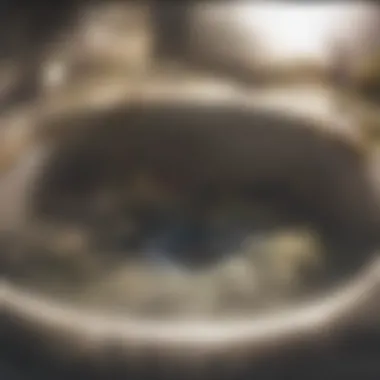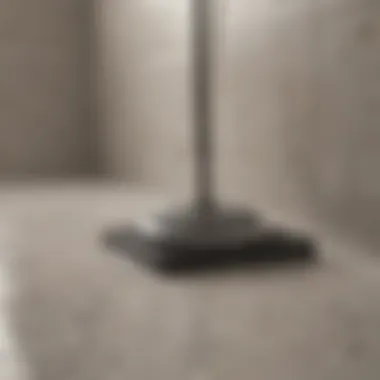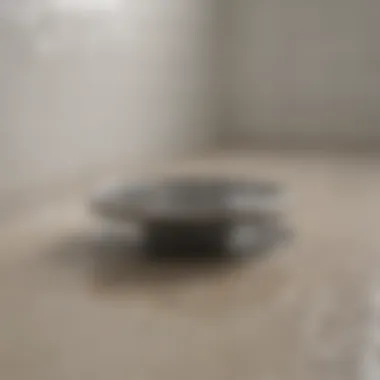Effective Techniques for Cleaning Shower Drains


Intro
Shower drains can quickly become a source of frustration, especially when clogged with hair. This issue is not just a nuisance; it can lead to unpleasant odors and potential plumbing problems. Understanding the root of these clogs is essential for effective maintenance. By tackling hair accumulation early, homeowners can avoid more costly plumbing interventions in the long run.
In this article, you will discover various techniques to clean shower drains effectively. Whether you prefer DIY solutions or commercial products, strategies are available to suit your approach. Additionally, we will discuss essential tools, preventive measures, and step-by-step guides for various cleaning methods. By the end, you will have the knowledge required to maintain clear and odor-free shower drains.
Feature Spotlight
While the focus is on cleaning techniques, certain features of a well-maintained shower drain can enhance efficiency.
Effective Drain Design
Choosing a shower drain with a built-in hair trap can significantly reduce clogs. These designs capture hair before it travels further down the plumbing system. Examples include:
- Grate-style drains that catch hair efficiently.
- Innovative pop-up drains that are easy to access for cleaning.
Material Considerations
Opting for high-quality materials is another practical way to ensure durability and reduce the frequency of clogs.
- Stainless steel drains resist corrosion and are easier to clean.
- Plastic drains may be less expensive but can degrade faster.
Tools Required
Before starting the cleaning process, gather the necessary tools. Some common items include:
- A pair of gloves to protect your hands.
- A plunger for stubborn clogs.
- A plumber’s snake for deeper blockages.
- Baking soda and vinegar for a natural cleaning approach.
These tools will streamline the cleaning process and enable you to handle various levels of clogging effectively.
"Regular maintenance of shower drains can save homeowners from extensive plumbing costs down the line."
As the article progresses, we will look at specific methods for tackling hair blockages, from simple home remedies to more advanced cleaning techniques.
Prelude to Shower Drain Clogs
Shower drains commonly face clogs that cause frustration. Understanding these clogs is vital for effective maintenance. Clogs can lead to unpleasant odors and plumbing issues, disrupting daily routines. This article aims to provide a thorough guide on managing hair-related clogs in shower drains.
Understanding the Nature of Clogs
Clogs in shower drains occur due to a buildup of various materials. Typically, this includes hair, soap residue, and other debris. Over time, these materials accumulate, reducing water flow. When a clog occurs, it may manifest as slow drainage or complete blockages.
The nature of these clogs is largely dependent on the frequency of cleaning and the products used in the shower. Regular maintenance becomes essential to prevent such issues. Understanding how hair and other substances interact can help in adopting better preventive strategies.
Why Hair is a Common Culprit


Hair is perhaps the most infamous contributor to shower drain clogs. Individuals shed hair daily, and many do not realize how much ends up in the drain. Long hair is particularly problematic, as it easily entwines with soap scum and other debris, forming thicker clumps.
Moreover, hair is not easily broken down like organic waste. This makes it problematic when it combines with other materials. Hair clogs not only impede water flow but can also create blockages further down the plumbing system.
In summary, understanding the causes of shower drain clogs, particularly the role of hair, equips individuals with the knowledge needed to maintain their showers effectively. This foundational knowledge paves the way for exploring preventive measures and effective cleaning techniques.
Preventive Measures to Minimize Clogs
Effective prevention is crucial for maintaining clear shower drains. Implementing preventive measures can significantly reduce the frequency and severity of clogs caused by hair. Proper prevention not only saves time and money, but it also promotes a more hygienic environment by eliminating foul odors and potential plumbing issues. Engaging in preventive practices can lead to smoother water flow and save you from the hassle of performing extensive cleaning.
Regular Maintenance Practices
Regular maintenance is essential to ensure that your shower drains function properly. One of the best practices is to clean the drain grates regularly. Hair and soap residue can accumulate quickly. By removing visible hair and debris from the grate, you can prevent buildup from forming deeper within the pipes. Consider using a simple tool, such as tweezers, to fetch hair strands that settle at the base of the drain.
Another important practice is to flush your drains with hot water periodically. Hot water helps dissolve soap scum and grease, clearing minor blockages before they worsen. Try to perform this flushing weekly; this will assist in maintaining an efficient drainage system.
Maintaining a routine can catch problems before they escalate. Regularly checking the pipes and fitting for any leaks or corrosion helps you address potential issues early.
Installing Drain Covers
Using drain covers is a straightforward yet effective solution. Drain covers, often made of metal or plastic, work by trapping hair and larger particles before they enter the drainage system. Choosing the right cover is vital; look for one with fine mesh to catch even small strands of hair.
Installing a drain cover is an easy do-it-yourself task. Simply place it over the drain opening. It can be easily removed when you're ready to clean.
Benefits of using drain covers include:
- Cost-effectiveness: They are generally inexpensive and can last for years.
- Ease of use: Removing and cleaning them is simple.
- Versatility: They come in various styles that can fit with your bathroom decor.
Using a combination of regular maintenance practices alongside drain covers creates a solid foundation for minimizing clogs. This proactive approach leads to greater plumbing health over time.
Essential Tools for Cleaning Shower Drains
Cleaning shower drains effectively requires the right tools. Having proper instruments not only makes the task easier but also helps in achieving a thorough clean. The presence of hair and other debris can lead to significant problems if not addressed promptly. Thus, understanding which tools to use is essential for maintaining hygiene and function.
Basic Household Tools
Many tools can be found around the house that are useful for cleaning shower drains. These are typically inexpensive and widely available:
- Plunger: A basic tool that can help dislodge minor clogs without the use of chemicals.
- Wire hanger: This can be shaped into a hook, making it effective for pulling hair and gunk out of the drain.
- Bucket: Important for collecting any debris that is removed, keeping the area clean during the process.
- Old toothbrush: Perfect for scrubbing at any residue that builds up around the drain cover.
Each of these tools plays a crucial role in the cleaning process. A plunger may help when water is standing still, while a wire hanger is specifically useful for hair blockage.
Chemical Products and Alternatives
For those tougher clogs, chemical products can sometimes provide a solution. However, there are considerations:


- Commercial Drain Cleaners: Products like Drano or Liquid-Plumr can dissolve hair and other materials. They work quickly but can sometimes cause damage to pipes if used excessively.
- Natural Alternatives: Baking soda and vinegar is a safe option for those wanting to avoid harsh chemicals. Combine the two in the drain, let sit for 30 minutes, and flush with hot water for best results.
- Enzymatic Drain Cleaners: These are more eco-friendly and use bacteria to break down organic material. They often work slower than chemical versions but are generally safer for pipes and the environment.
"Choosing the right tool or solution can significantly affect the cleanliness and functionality of your shower drain."
Step-by-Step Cleaning Techniques
Cleaning shower drains clogged with hair requires methodical approaches to ensure effectiveness. This section provides clear instructions on multiple techniques. By mastering these processes, one can tackle the clog efficiently, avoiding potential damages and costly repairs. It is essential to address these issues promptly to maintain a functional drainage system, and knowing the appropriate techniques can save both time and effort.
Manual Removal of Hair
Manual removal is often the first step in addressing hair-clogged shower drains. It is simple yet effective. Start by removing the drain cover if applicable. Use a pair of gloves to protect your hands. With your fingers or a small tool, such as a spoon or a wire hanger, pull out the hair clumps that are accessible. This method is beneficial because it does not involve chemicals, making it safe for both the drain and the environment.
Important Considerations:
- Ensure you remove a significant amount of hair before proceeding to other methods.
- Dispose of the hair properly to prevent future clogs in other areas.
Using a Plumber's Snake
A plumber's snake is a versatile tool for deeper and tougher clogs. This tool enables you to reach stubborn hair blockages that manual methods might miss. To use it, insert the snake into the drain until you feel resistance, then twist and push gently. The snake’s coiled end can catch the hair, allowing you to pull it out. This technique can effectively clear even significant blockages.
Benefits of Using a Plumber's Snake:
- It reaches deeper clogs based on its length and flexibility.
- Reduces the need for harsh chemicals.
Applying Chemical Drain Cleaners
Chemical drain cleaners are powerful solutions designed to dissolve clogs caused by hair and other debris. Choose a product with enzymes or caustic agents specifically for hair removal. Follow the manufacturer's instructions carefully. Generally, pour the cleaner down the drain and let it sit for the recommended time. Afterward, flush with hot water. This method can provide quick relief for persistent clogs.
Natural Cleaning Solutions
For those preferring a more environmentally friendly approach, natural cleaning solutions offer effective alternatives. A mixture of baking soda and vinegar is a common choice. Begin by pouring half a cup of baking soda down the drain, followed by a half cup of vinegar. The combination creates a fizzing reaction that can help loosen hair and debris. After letting it sit for about 30 minutes, flush the drain with hot water. This method is not only safe but also cost-effective.
Additional Options:
- Use hot water alone, poured directly down the drain, to help break down minor build-up.
- Salt and boiling water can also serve as an effective natural method by breaking down greasy substances.
In summary, each technique has its strengths. Depending on the severity of the clog, combining methods may yield the best results.
Aftercare for Shower Drain Maintenance
Maintaining shower drains is not just about cleaning them when they clog; it is also about ensuring they remain clear and functional over time. Aftercare entails routine practices that help prevent future issues, which can save both time and money. Understanding how to effectively care for your drains can enhance their longevity and reduce the risk of major plumbing problems.
Flushing with Hot Water
One effective method for maintaining a clean shower drain is flushing it regularly with hot water. This process helps to dissolve soap scum and other residues that may accumulate in the drain. When hot water flows through the pipes, it loosens debris and encourages smoother drainage. A good practice is to perform this procedure weekly. Simply run hot water down the drain for several minutes.


Regular flushing with hot water can notably decrease the frequency of clogs.
Routine Inspections
Routine inspections of your shower drain are also crucial for effective aftercare. Observing the drain's performance can help identify any early signs of a problem. For example, if water drains slowly or if you notice unpleasant odors, these may be indicators that a clog is developing. Inspecting the drain visually for hair buildup or other material can also guide timely cleaning efforts.
Incorporating a routine inspection can be easy. Set aside a few minutes monthly to check the drain. Consider these tips for an effective inspection:
- Look for visible hair or debris around the drain cover.
- Listen for unusual sounds when water drains, as these can be signs of obstruction.
- Check the water level in the shower after use to ensure proper drainage.
By adopting these aftercare techniques, you not only maintain your shower drains but also contribute to a healthier home environment.
Understanding When to Call a Professional
Understanding when to seek professional help for clogged shower drains is crucial. Many homeowners attempt to resolve the issue themselves with various DIY techniques. While this is often effective for minor clogs, it is essential to realize the limitations of these methods. Knowing when to escalate the situation can save time, money, and further damage to plumbing systems.
Identifying Serious Drain Issues
Some signs indicate that a clog may be severe enough to require expert intervention. Here are a few:
- Recurring Problems: If the clog occurs frequently, there may be an underlying issue such as tree roots in pipes or damaged sections.
- Foul Smells: Persistent, unpleasant odors emanating from the drain can suggest decomposing organic matter trapped within the pipes.
- Slow Draining: When water drains slowly despite cleaning efforts, it might point to serious blockages deep within the plumbing.
- Backflow: If water begins to backflow into the shower or other areas, immediate professional help is necessary as this may signify complete blockage.
Recognizing these signs early can prevent larger plumbing failures. Ignoring these issues may lead to extensive repairs and costly damage.
Cost-Benefit Analysis of Professional Services
Engaging a professional plumber entails evaluating both associated costs and benefits. Here are considerations to keep in mind:
Costs
- Service Fees: Plumbers often charge by the hour or offer flat rates for specific services. This can vary greatly depending on your location.
- Materials Needed: Sometimes, a professional will need special tools or materials to complete the job, adding to the expense.
Benefits
- Expertise: Professionals have the training and experience to handle complex drainage issues efficiently. They can diagnose problems that laypeople might overlook.
- Time-Saving: Hiring a plumber can save time, especially for significant clogs that require extensive work. You are more likely to receive a resolution faster than attempting multiple DIY solutions.
- Preventive Measures: A skilled plumber can offer advice or services that prevent future clogs. Their assessment can help homeowners implement better practices moving forward.
When weighing these factors, it may be worth investing in professional services before minor problems escalate into costly disasters. By understanding both the potential costs and advantages, homeowners can make informed decisions when addressing shower drain clogs.
The End
Summarizing Key Points
To encapsulate the insights discussed:
- Hair as a Common Cause: Hair accumulation is a primary reason for shower drain clogs. Regular cleaning and preventive measures can mitigate this issue.
- Essential Tools: Employing the right tools and techniques, such as plumber's snakes, drain covers, and natural cleaning solutions, provide effective interventions.
- Step-by-Step Methods: Detailed cleaning methods offer a structured approach to tackling clogs, empowering homeowners to resolve issues independently.
- Aftercare Practices: Post-cleaning care, including regular inspections and hot water flushing, fosters long-term maintenance.
- Professional Help: Knowing when to consult professionals ensures that serious problems do not escalate.
Encouraging Regular Maintenance
Routine maintenance reflects a proactive approach to drain management. Implementing regular checks on shower drains can significantly reduce the likelihood of hair accumulation. Simple actions can create a notable impact:
- Set a Schedule: Establish a regular cleaning schedule that incorporates the removal of hair and debris from strainers and traps.
- Use Drain Screens: Installing mesh screens can catch hair before it enters the drain, making maintenance easier and less frequent.
- Educate Household Members: Raising awareness among family members or roommates about the importance of cleaning can foster collective responsibility.







